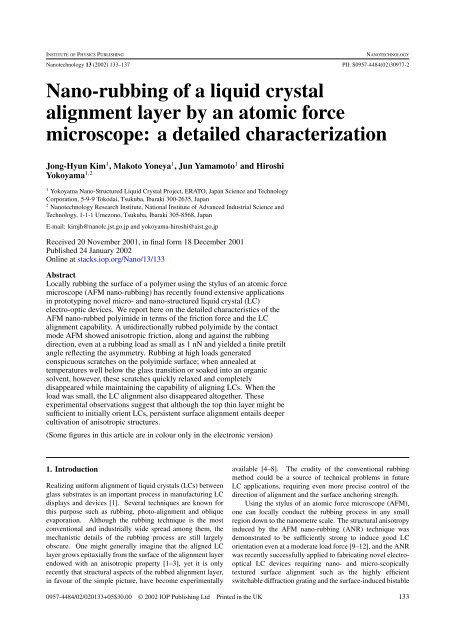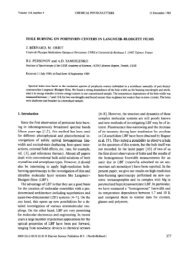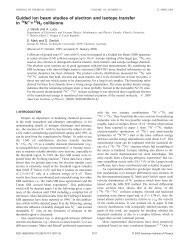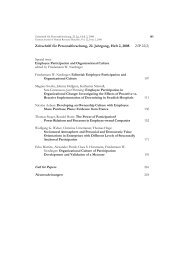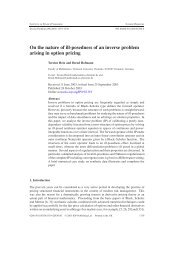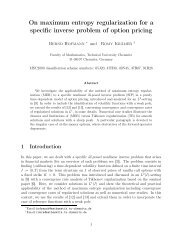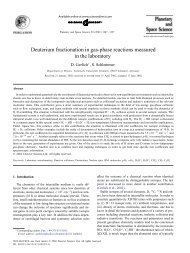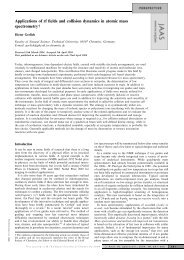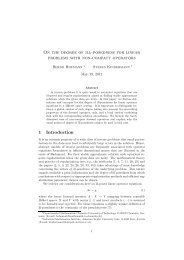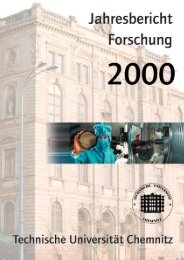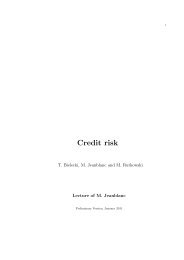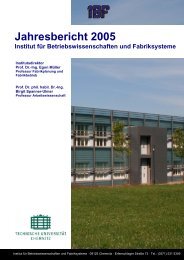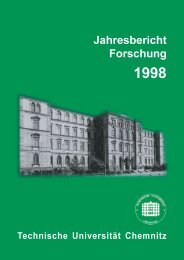Nano-rubbing of a liquid crystal alignment layer by an atomic force ...
Nano-rubbing of a liquid crystal alignment layer by an atomic force ...
Nano-rubbing of a liquid crystal alignment layer by an atomic force ...
Create successful ePaper yourself
Turn your PDF publications into a flip-book with our unique Google optimized e-Paper software.
INSTITUTE OF PHYSICS PUBLISHING NANOTECHNOLOGY<br />
<strong>N<strong>an</strong>o</strong>technology 13 (2002) 133–137 PII: S0957-4484(02)30977-2<br />
<strong>N<strong>an</strong>o</strong>-<strong>rubbing</strong> <strong>of</strong> a <strong>liquid</strong> <strong>crystal</strong><br />
<strong>alignment</strong> <strong>layer</strong> <strong>by</strong> <strong>an</strong> <strong>atomic</strong> <strong>force</strong><br />
microscope: a detailed characterization<br />
Jong-Hyun Kim 1 , Makoto Yoneya 1 , Jun Yamamoto 1 <strong>an</strong>d Hiroshi<br />
Yokoyama 1,2<br />
1 Yokoyama <strong>N<strong>an</strong>o</strong>-Structured Liquid Crystal Project, ERATO, Jap<strong>an</strong> Science <strong>an</strong>d Technology<br />
Corporation, 5-9-9 Tokodai, Tsukuba, Ibaraki 300-2635, Jap<strong>an</strong><br />
2 <strong>N<strong>an</strong>o</strong>technology Research Institute, National Institute <strong>of</strong> Adv<strong>an</strong>ced Industrial Science <strong>an</strong>d<br />
Technology, 1-1-1 Umezono, Tsukuba, Ibaraki 305-8568, Jap<strong>an</strong><br />
E-mail: kimjh@n<strong>an</strong>olc.jst.go.jp <strong>an</strong>d yokoyama-hiroshi@aist.go.jp<br />
Received 20 November 2001, in final form 18 December 2001<br />
Published 24 J<strong>an</strong>uary 2002<br />
Online at stacks.iop.org/<strong>N<strong>an</strong>o</strong>/13/133<br />
Abstract<br />
Locally <strong>rubbing</strong> the surface <strong>of</strong> a polymer using the stylus <strong>of</strong> <strong>an</strong> <strong>atomic</strong> <strong>force</strong><br />
microscope (AFM n<strong>an</strong>o-<strong>rubbing</strong>) has recently found extensive applications<br />
in prototyping novel micro- <strong>an</strong>d n<strong>an</strong>o-structured <strong>liquid</strong> <strong>crystal</strong> (LC)<br />
electro-optic devices. We report here on the detailed characteristics <strong>of</strong> the<br />
AFM n<strong>an</strong>o-rubbed polyimide in terms <strong>of</strong> the friction <strong>force</strong> <strong>an</strong>d the LC<br />
<strong>alignment</strong> capability. A unidirectionally rubbed polyimide <strong>by</strong> the contact<br />
mode AFM showed <strong>an</strong>isotropic friction, along <strong>an</strong>d against the <strong>rubbing</strong><br />
direction, even at a <strong>rubbing</strong> load as small as 1 nN <strong>an</strong>d yielded a finite pretilt<br />
<strong>an</strong>gle reflecting the asymmetry. Rubbing at high loads generated<br />
conspicuous scratches on the polyimide surface; when <strong>an</strong>nealed at<br />
temperatures well below the glass tr<strong>an</strong>sition or soaked into <strong>an</strong> org<strong>an</strong>ic<br />
solvent, however, these scratches quickly relaxed <strong>an</strong>d completely<br />
disappeared while maintaining the capability <strong>of</strong> aligning LCs. When the<br />
load was small, the LC <strong>alignment</strong> also disappeared altogether. These<br />
experimental observations suggest that although the top thin <strong>layer</strong> might be<br />
sufficient to initially orient LCs, persistent surface <strong>alignment</strong> entails deeper<br />
cultivation <strong>of</strong> <strong>an</strong>isotropic structures.<br />
(Some figures in this article are in colour only in the electronic version)<br />
1. Introduction<br />
Realizing uniform <strong>alignment</strong> <strong>of</strong> <strong>liquid</strong> <strong>crystal</strong>s (LCs) between<br />
glass substrates is <strong>an</strong> import<strong>an</strong>t process in m<strong>an</strong>ufacturing LC<br />
displays <strong>an</strong>d devices [1]. Several techniques are known for<br />
this purpose such as <strong>rubbing</strong>, photo-<strong>alignment</strong> <strong>an</strong>d oblique<br />
evaporation. Although the <strong>rubbing</strong> technique is the most<br />
conventional <strong>an</strong>d industrially wide spread among them, the<br />
mech<strong>an</strong>istic details <strong>of</strong> the <strong>rubbing</strong> process are still largely<br />
obscure. One might generally imagine that the aligned LC<br />
<strong>layer</strong> grows epitaxially from the surface <strong>of</strong> the <strong>alignment</strong> <strong>layer</strong><br />
endowed with <strong>an</strong> <strong>an</strong>isotropic property [1–3], yet it is only<br />
recently that structural aspects <strong>of</strong> the rubbed <strong>alignment</strong> <strong>layer</strong>,<br />
in favour <strong>of</strong> the simple picture, have become experimentally<br />
available [4–8]. The crudity <strong>of</strong> the conventional <strong>rubbing</strong><br />
method could be a source <strong>of</strong> technical problems in future<br />
LC applications, requiring even more precise control <strong>of</strong> the<br />
direction <strong>of</strong> <strong>alignment</strong> <strong>an</strong>d the surface <strong>an</strong>choring strength.<br />
Using the stylus <strong>of</strong> <strong>an</strong> <strong>atomic</strong> <strong>force</strong> microscope (AFM),<br />
one c<strong>an</strong> locally conduct the <strong>rubbing</strong> process in <strong>an</strong>y small<br />
region down to the n<strong>an</strong>ometre scale. The structural <strong>an</strong>isotropy<br />
induced <strong>by</strong> the AFM n<strong>an</strong>o-<strong>rubbing</strong> (ANR) technique was<br />
demonstrated to be sufficiently strong to induce good LC<br />
orientation even at a moderate load <strong>force</strong> [9–12], <strong>an</strong>d the ANR<br />
was recently successfully applied to fabricating novel electrooptical<br />
LC devices requiring n<strong>an</strong>o- <strong>an</strong>d micro-scopically<br />
textured surface <strong>alignment</strong> such as the highly efficient<br />
switchable diffraction grating <strong>an</strong>d the surface-induced bistable<br />
0957-4484/02/020133+05$30.00 © 2002 IOP Publishing Ltd Printed in the UK 133
J-H Kim et al<br />
nematic devices [13–16]. Despite its obvious drawbacks<br />
such as limited size <strong>an</strong>d long processing time, the ANR<br />
technique enables, <strong>by</strong> its nature, us to precisely control the<br />
direction <strong>an</strong>d strength <strong>of</strong> <strong>rubbing</strong>, which is hardly possible<br />
in the conventional <strong>rubbing</strong> process. It is thus expected<br />
to be useful in exploring the underlying mech<strong>an</strong>ism <strong>of</strong> the<br />
<strong>rubbing</strong> process as well. It has indeed been shown that the<br />
azimuthal <strong>an</strong>choring strength grows systematically with the<br />
increase in sc<strong>an</strong>ning density <strong>an</strong>d load <strong>force</strong> [15]. The purpose<br />
<strong>of</strong> this paper is to describe in more detail the characteristics<br />
<strong>of</strong> the ANR on polyimide <strong>alignment</strong> <strong>layer</strong>s in terms <strong>of</strong> the<br />
topographical <strong>an</strong>d frictional ch<strong>an</strong>ges in relation to the LC<br />
<strong>alignment</strong> capability. We demonstrate, in particular, that the<br />
unidirectional <strong>rubbing</strong> c<strong>an</strong> generate finite tilt <strong>an</strong>gles <strong>of</strong> the<br />
LC <strong>alignment</strong> in a systematic m<strong>an</strong>ner reflecting the degree<br />
<strong>of</strong> asymmetry induced <strong>by</strong> the ANR.<br />
2. Experiment<br />
Substrates were glass slides spin-coated with a <strong>layer</strong> <strong>of</strong><br />
polyimide (SE150, Niss<strong>an</strong> Chemical). This polyimide is a<br />
main-chain type polymer, which is known to yield industrialquality<br />
pl<strong>an</strong>ar <strong>alignment</strong> <strong>of</strong> LCs on <strong>rubbing</strong>. Spin coating <strong>of</strong> the<br />
precursory polyamic acids was carried out at the rotation speed<br />
<strong>of</strong> 2500 rpm for 20 s. The coated substrate was then baked<br />
at 180 ◦ C for 1–2 h to completely imidize the precursor film<br />
to the final thickness <strong>of</strong> several hundred n<strong>an</strong>ometres. There<br />
was no clear indication <strong>of</strong> baking-time dependence in all the<br />
experiments reported here.<br />
<strong>N<strong>an</strong>o</strong>-<strong>rubbing</strong> was carried out <strong>by</strong> a commercial AFM<br />
(SPI-500, SEIKO Instruments) in the contact mode under<br />
various load <strong>force</strong> using a st<strong>an</strong>dard c<strong>an</strong>tilever (Si-AF01,<br />
SEIKO Instruments). For experimenting with small sc<strong>an</strong>ning<br />
densities, fresh c<strong>an</strong>tilevers were always employed to ensure<br />
reliability. However, a prolonged use was inevitable for highdensity<br />
<strong>an</strong>d/or large-area <strong>rubbing</strong> sc<strong>an</strong>s. The fresh tip had<br />
a 10 nm radius <strong>of</strong> curvature at the apex 3 , which became<br />
two times more blunt after continuous use as a result <strong>of</strong><br />
accumulation <strong>of</strong> the polymer debris. As a consequence, a new<br />
tip generated more distinctive scratches compared to a used one<br />
for a given <strong>force</strong>. However, the LC <strong>alignment</strong> quality remained<br />
indistinguishable within the present experimental resolution.<br />
The actual movement <strong>of</strong> the c<strong>an</strong>tilever in the st<strong>an</strong>dard<br />
contact mode <strong>of</strong> the AFM consists <strong>of</strong> repeated cycles <strong>of</strong> a<br />
complete line sc<strong>an</strong> (forward <strong>an</strong>d backward along the same<br />
path) followed <strong>by</strong> tr<strong>an</strong>slation to the end <strong>of</strong> the next line under<br />
the const<strong>an</strong>t load. For the pretilt <strong>an</strong>gle generation that requires<br />
asymmetrical <strong>rubbing</strong>, however, we modified the movement <strong>of</strong><br />
c<strong>an</strong>tilever into a unidirectional sc<strong>an</strong>ning so that the c<strong>an</strong>tilever<br />
is loaded only for the forward sc<strong>an</strong>, but is retracted from the<br />
surface during the backward motion.<br />
The load <strong>force</strong> for the present ANR was limited below<br />
∼30 nN in order to avoid disruption <strong>of</strong> the tip geometry as much<br />
as possible. Note that this load r<strong>an</strong>ge is considerably low in<br />
comparison with those adopted <strong>by</strong> previous workers [9–12,15],<br />
who used hard (probably highly <strong>crystal</strong>line) polyimides such<br />
as LX-1400 (Hitachi Chemical). For these stiff polyimides,<br />
the effects <strong>of</strong> ANR c<strong>an</strong> barely appear in this low <strong>an</strong>d moderate<br />
3 M<strong>an</strong>ufacturer’s specifications.<br />
134<br />
Figure 1. Topography images <strong>of</strong> the ANR processed polyimide<br />
surface under different load <strong>force</strong>s. The load <strong>force</strong>s are (a)23nN,<br />
(b) 16 nN, (c)9nN<strong>an</strong>d(d) 2 nN. The sc<strong>an</strong>ning speed was 2 µms −1 .<br />
<strong>force</strong> r<strong>an</strong>ge, there<strong>by</strong> making it extremely difficult to undertake<br />
detailed characterization <strong>of</strong> ANR processes without subst<strong>an</strong>tial<br />
deterioration <strong>of</strong> tips. For this reason, we chose the s<strong>of</strong>ttype<br />
polyimide as described above. Although relatively s<strong>of</strong>t,<br />
the polyimide is still a highly durable polymer whose glass<br />
tr<strong>an</strong>sition temperature has been confirmed to be at least above<br />
200 ◦ C according to our differential sc<strong>an</strong>ning calorimetry<br />
<strong>an</strong>d rheological experiments. For topographic <strong>an</strong>d friction<br />
imaging, the load <strong>force</strong> was maintained below 1 nN to<br />
minimize destruction <strong>of</strong> processed surfaces; no appreciable<br />
ch<strong>an</strong>ges in topographical images were in fact observed even<br />
after repeated measurement at room temperature.<br />
The LC textures were observed <strong>by</strong> optical polarizing<br />
microscopy, <strong>an</strong>d the pretilt <strong>an</strong>gle was measured at room<br />
temperature <strong>by</strong> the <strong>crystal</strong> rotation method. The LC<br />
was 4-n-pentyl-4 ′ -cy<strong>an</strong>obiphenyl (5CB), which is a roomtemperature<br />
nematic LC with the nematic-isotropic tr<strong>an</strong>sition<br />
point at 35.3 ◦ C.<br />
3. Atomic <strong>force</strong> microscopy<br />
Scratches, which are ubiquitous on conventionally rubbed<br />
polyimide surfaces, were also generated in a far more<br />
controlled m<strong>an</strong>ner <strong>by</strong> the ANR at relatively high load <strong>force</strong>s as<br />
shown in figure 1. Parallel long lines are the scratches caused<br />
<strong>by</strong> ANR, <strong>an</strong>d those along the side <strong>of</strong> the rubbed area are due to<br />
the tr<strong>an</strong>slation <strong>of</strong> the tip to the starting position <strong>of</strong> the next line.<br />
In figure 1(a) obtained for the load <strong>force</strong> <strong>of</strong> 23 nN, scratches<br />
are clear <strong>an</strong>d their typical depth <strong>an</strong>d width were 1 <strong>an</strong>d 50 nm,<br />
respectively. As the load is reduced down below 10 nN,<br />
however, the ANR left no more th<strong>an</strong> a faint shadow <strong>of</strong> sc<strong>an</strong>ning<br />
(figures 1(c) <strong>an</strong>d (d)), though these surfaces exhibit a fairly<br />
good LC <strong>alignment</strong> as will be described below.
Figure 2. Friction image <strong>of</strong> the polyimide surface, which contains<br />
two areas with opposite sc<strong>an</strong>ning directions to each other. The two<br />
squares were sc<strong>an</strong>ned before friction measuring. Because <strong>of</strong> the<br />
imaging direction, the darker area has larger friction th<strong>an</strong> the<br />
brighter one. The image was amplified to put emphasis on the<br />
distinction <strong>of</strong> signals. The arrows indicate sc<strong>an</strong>ning <strong>an</strong>d imaging<br />
directions, respectively. The sc<strong>an</strong>ning density was 150 line/µm.<br />
The <strong>force</strong> was 3 nN. The speed was 30 µms −1 . The imaging <strong>force</strong><br />
was less th<strong>an</strong> 1 nN.<br />
The tip size <strong>an</strong>d the shape <strong>of</strong> the scratches in figure 1 do not<br />
fit with each other. For the given depth <strong>of</strong> the scratch, the width<br />
is much larger th<strong>an</strong> the tip diameter. The diameter <strong>of</strong> the tip at<br />
the point 1nm away from the apex is only around 10 nm, given<br />
the 10 nm radius <strong>of</strong> curvature <strong>of</strong> the tip. It then follows that the<br />
tip must have penetrated deeper into the bulk th<strong>an</strong> apparently<br />
seen in the topographic image. The pyramidal shape <strong>of</strong> the<br />
tip, having the maximum <strong>of</strong> 60 ◦ cone <strong>an</strong>gle (see footnote 3)<br />
requires that the depth <strong>of</strong> penetration at the time <strong>of</strong> scratch<br />
formation should be about 30 nm to yield the width <strong>of</strong> 50 nm.<br />
The deep scratches thus formed initially might have relaxed<br />
to the observed shape rather quickly due to the s<strong>of</strong>tness <strong>of</strong> the<br />
polyimide.<br />
When the sc<strong>an</strong>ning density was as high as 100 line/µm<br />
(10 nm line separation), it became virtually impossible to<br />
distinguish individual scratch lines irrespective <strong>of</strong> the load<br />
<strong>force</strong>. This is a natural consequence <strong>of</strong> the larger width <strong>of</strong><br />
scratches th<strong>an</strong> the sc<strong>an</strong>ning interval. The ANR processed<br />
area, however, was still recognizable over the rest in terms<br />
<strong>of</strong> a slight increase in overall height, or more clearly <strong>of</strong> <strong>an</strong><br />
increase in friction (lateral <strong>force</strong>). Regardless <strong>of</strong> the load <strong>force</strong>,<br />
the friction was found to steadily increase relative to the nonsc<strong>an</strong>ned<br />
area. We measured, in particular, the <strong>an</strong>isotropy <strong>of</strong><br />
friction on the ANR processed area relative to the rubbed<br />
direction at the high-density sc<strong>an</strong>ning. For unidirectional<br />
ANR, the friction <strong>an</strong>tiparallel to the rubbed direction was<br />
found to be appreciably lower th<strong>an</strong> that along the <strong>rubbing</strong><br />
direction (figure 2). Similar <strong>an</strong>isotropic friction has been<br />
observed for L<strong>an</strong>gmuir–Blodgett mono<strong>layer</strong>s <strong>of</strong> tilted lipid<br />
molecules deposited on solid surfaces [17, 18]. An intuitively<br />
appealing expl<strong>an</strong>ation for this <strong>an</strong>isotropic friction is that the<br />
tilted molecules allow smoother passage <strong>of</strong> <strong>an</strong> AFM tip along<br />
the tilt direction th<strong>an</strong> against it, just as the situation we<br />
experience in combing hair. According to the recent sum<br />
frequency generation (SFG) studies <strong>of</strong> rubbed polyimide <strong>by</strong><br />
Oh-e et al [7], indeed, the main-chain <strong>of</strong> polyimide tends to<br />
<strong>N<strong>an</strong>o</strong>-<strong>rubbing</strong> <strong>of</strong> a <strong>liquid</strong> <strong>crystal</strong> <strong>alignment</strong> <strong>layer</strong> <strong>by</strong> <strong>an</strong> <strong>atomic</strong> <strong>force</strong> microscope: a detailed characterization<br />
a b<br />
Figure 3. Ch<strong>an</strong>ges <strong>of</strong> the topography image with the thermal<br />
ageing. (a) After sc<strong>an</strong>ning at 20 ◦ C, (b) after ageing at 60 ◦ C<br />
for 10 min. The measurement was at 20 ◦ C. The sc<strong>an</strong>ning <strong>force</strong><br />
was 30 nN. The imaging <strong>force</strong> was less th<strong>an</strong> 1 nN.<br />
attain a finite tilt out <strong>of</strong> the pl<strong>an</strong>e <strong>of</strong> the substrate when subjected<br />
to unidirectional <strong>rubbing</strong>. It, therefore, seems reasonable to<br />
suspect that the similar tilting <strong>of</strong> main chain took place, giving<br />
rise to the <strong>an</strong>isotropic friction.<br />
In order to study the structural relaxation <strong>of</strong> the ANR<br />
processed polymer substrate, the processed samples were<br />
soaked in <strong>an</strong> isopropyl alcohol supersonic bath for 15 min<br />
at room temperature. The scratches made <strong>by</strong> the ANR<br />
disappeared altogether for all the ANR conditions. The<br />
temperature stability <strong>of</strong> the scratches was also examined as<br />
shown in figure 3. The processed substrates were heated<br />
up to the target temperature <strong>an</strong>d maintained for 10 min,<br />
<strong>an</strong>d were cooled to room temperature for AFM imaging.<br />
This cycle was started at room temperature with successively<br />
increasing the target temperature. The relaxation <strong>of</strong> scratches<br />
was found to become appreciable even at a temperature <strong>of</strong><br />
60 ◦ C, <strong>an</strong>d was enh<strong>an</strong>ced at higher temperatures. The friction<br />
image also beg<strong>an</strong> to fade away at 70 ◦ C. In view <strong>of</strong> the<br />
intrinsically high glass tr<strong>an</strong>sition temperature <strong>of</strong> the polyimide<br />
used (at least 200 ◦ C), the observed relaxation temperature is<br />
surprisingly low, <strong>an</strong>d should have a signification impact on the<br />
surface <strong>alignment</strong> <strong>of</strong> LCs. One probable expl<strong>an</strong>ation is that,<br />
the glass tr<strong>an</strong>sition may be easier to occur at surfaces where<br />
the ent<strong>an</strong>glement <strong>of</strong> polymer chains are less signific<strong>an</strong>t th<strong>an</strong> in<br />
the bulk [19].<br />
4. Liquid <strong>crystal</strong> <strong>alignment</strong> property<br />
Figure 4(a) shows the polarizing optical micrograph <strong>of</strong> the<br />
result<strong>an</strong>t LC <strong>alignment</strong>. A <strong>layer</strong> <strong>of</strong> LC was put on the ANR<br />
processed polyimide with a free upper boundary where the LC<br />
molecules are self-aligned perpendicular to the free surface.<br />
The thickness <strong>of</strong> the LC <strong>layer</strong> was not strictly controlled, but<br />
was limited within the depth <strong>of</strong> focus <strong>of</strong> the microscope. The<br />
quality <strong>of</strong> LC <strong>alignment</strong> was found almost invariable with<br />
diverse sc<strong>an</strong>ning conditions. In particular, even at the load<br />
<strong>force</strong> as low as the usual imaging level (1 nN or less), the<br />
capability <strong>of</strong> the sc<strong>an</strong>ned area to give uniform LC <strong>alignment</strong><br />
is clearly seen. Though all the ANR patterns were <strong>of</strong> the<br />
same size, regions rubbed at lower load <strong>force</strong>s seem to have<br />
smaller effective size due to the elastic frustrations with the<br />
surrounding LC <strong>alignment</strong>.<br />
135
J-H Kim et al<br />
Figure 4. LC texture ch<strong>an</strong>ges for sc<strong>an</strong>ning conditions <strong>an</strong>d washing,<br />
(a) shows the textures before washing <strong>an</strong>d (b) after washing. The<br />
conditions <strong>of</strong> the sc<strong>an</strong>ning are (23 nN, 6 line/µm), (23 nN,<br />
1 line/µm), (1 nN, 1 line/µm) <strong>an</strong>d (1 nN, 6 line/µm) for load <strong>force</strong><br />
<strong>an</strong>d line density from left bottom in counter-clockwise. Every<br />
pattern has size <strong>of</strong> 10 µm × 10 µm. The optical image was got with<br />
maximum contrast between sc<strong>an</strong>ned area <strong>an</strong>d non-sc<strong>an</strong>ned area<br />
under crossed polarizers.<br />
The ANR processed substrate was soaked in the<br />
supersonic bath containing isopropyl alcohol for 10 min at<br />
room temperature. The LC was then put on that substrate to<br />
observe texture. Unlike the case <strong>of</strong> scratches, domains rubbed<br />
at relative high load <strong>force</strong>s retained their ability to align LC as<br />
shown in figure 4(b). The quality <strong>of</strong> LC <strong>alignment</strong>, however,<br />
varied following the ANR condition. The texture on 23 nN <strong>an</strong>d<br />
6 line/µm was practically the same before <strong>an</strong>d after washing.<br />
But in the case <strong>of</strong> 1 nN <strong>an</strong>d 1 line/µm sc<strong>an</strong>ning, the <strong>alignment</strong><br />
disappeared completely.<br />
Finally, we have explored the possibility <strong>of</strong> pretilt <strong>an</strong>gle<br />
generation <strong>by</strong> conducting unidirectional ANR. Initially, we<br />
confirmed that the pretilt <strong>an</strong>gle is zero, i.e. the LC molecules<br />
lying flat on the substrate, when the bi-directional sc<strong>an</strong>ning<br />
was carried out on the same line. The unidirectional sc<strong>an</strong>ning<br />
was executed at a const<strong>an</strong>t <strong>force</strong> <strong>an</strong>d speed for the size<br />
<strong>of</strong> 150 µm × 150 µm; this rather large size was chosen to<br />
allow a reliable optical measurement <strong>of</strong> the result<strong>an</strong>t pretilt<br />
<strong>an</strong>gle. Using the unidirectionally n<strong>an</strong>orubbed substrates,<br />
we fabricated a s<strong>an</strong>dwich-type homogeneous cell with the<br />
thickness <strong>of</strong> about 50 µm. The cell was then injected with<br />
the LC in the isotropic phase along the perpendicular direction<br />
to the <strong>alignment</strong> direction. The pretilt <strong>an</strong>gle was measured at<br />
room temperature <strong>by</strong> the <strong>crystal</strong> rotation method.<br />
Figure 5 shows the pretilt <strong>an</strong>gle as a function <strong>of</strong> the<br />
sc<strong>an</strong>ned line density. Despite considerable scatter <strong>of</strong> data,<br />
the pretilt <strong>an</strong>gle seemed, on average, to occur up to 2.5 ◦<br />
with the sc<strong>an</strong>ning density <strong>an</strong>d saturate in the high-density<br />
regime. The direction <strong>of</strong> tilting was along the sc<strong>an</strong>ning<br />
direction, which is the same behaviour as that in the case <strong>of</strong><br />
conventional <strong>rubbing</strong>. This, however, is not in accord<strong>an</strong>ce<br />
with the previous result [12]. Though a non-zero pretilt <strong>an</strong>gle<br />
was generated up to 2.5 ◦ in this experiment, this polyimide<br />
is known to yield a pretilt <strong>an</strong>gle as large as 5 degrees for<br />
the conventional <strong>rubbing</strong> 4 . This discrep<strong>an</strong>cy might be due to<br />
the different nature <strong>of</strong> the ANR <strong>an</strong>d the conventional <strong>rubbing</strong><br />
that the former is <strong>an</strong> essentially localized process at the tip<br />
apex whose shearing effect on the polyimide rapidly decays<br />
through the film thickness. The conventional <strong>rubbing</strong>, on the<br />
other h<strong>an</strong>d, consists in uniform shearing <strong>of</strong> the film surface<br />
4 M<strong>an</strong>ufacturer’s specifications.<br />
136<br />
Figure 5. Pretilt <strong>an</strong>gles generated <strong>by</strong> unidirectional ANR as a<br />
function <strong>of</strong> sc<strong>an</strong>ning density. The sc<strong>an</strong>ning speed was 500 µms −1<br />
<strong>an</strong>d the load <strong>force</strong> was 30 nN.<br />
<strong>an</strong>d hence its effect should penetrate through the polyimide<br />
<strong>layer</strong> without decay. In view <strong>of</strong> the fact that the longr<strong>an</strong>ge<br />
<strong>an</strong>isotropic interaction between the LC molecule <strong>an</strong>d<br />
the rubbed film is largely responsible for generation <strong>of</strong> pretilt<br />
<strong>an</strong>gle [20], the relatively smaller pretilt <strong>an</strong>gles found for the<br />
unidirectional ANR appear quite reasonable. In figure 5<br />
also shown are the ch<strong>an</strong>ges <strong>of</strong> pretilt <strong>an</strong>gle after ageing the<br />
sample in the isopropyl alcohol bath. As clearly seen, the<br />
pretilt <strong>an</strong>gle virtually disappeared after treatment, although the<br />
pretilt <strong>an</strong>gle on a conventionally rubbed surface withst<strong>an</strong>ds<br />
this solvent process. This observation is consistent with the<br />
above conjecture that the pretilt <strong>an</strong>gle on the ANR processed<br />
surface originates from the superficial region <strong>of</strong> the <strong>alignment</strong><br />
film.<br />
In order to further the argument a little more qu<strong>an</strong>titatively,<br />
we consider the mech<strong>an</strong>ical effect <strong>of</strong> the AFM tip on the surface<br />
<strong>of</strong> polyimide. For a given normal load <strong>force</strong> Fn <strong>an</strong>d the radius<br />
<strong>of</strong> tip–surface contact area R, the pressure that develops at the<br />
tip apex is given <strong>by</strong> the formula P = 4Fn/πR 2 [11]. If we<br />
adopt the yield stress <strong>of</strong> bulk polyimide, i.e. 1 GPa [21] for<br />
the present film, it follows from this equation that R = 1nm<br />
at Fn = 1 nN. Even for a fresh sharp tip with 10 nm radius<br />
<strong>of</strong> curvature, this estimate leads to the penetration depth <strong>of</strong><br />
the tip apex into the film to be <strong>an</strong> extremely small value<br />
<strong>of</strong> 0.05 nm. Given the deep scratches we observed, this is<br />
<strong>an</strong> unreasonably tiny value. In view <strong>of</strong> the unusually high<br />
susceptibility <strong>of</strong> the surface morphology <strong>an</strong>d the <strong>alignment</strong><br />
characteristics to the heat <strong>an</strong>d solvent treatments, it seems<br />
appropriate to consider that the surface region <strong>of</strong> the polyimide<br />
is subst<strong>an</strong>tially s<strong>of</strong>t compared to the bulk with much reduced<br />
glass tr<strong>an</strong>sition temperature <strong>an</strong>d yield stress [19].<br />
Finally, it should be <strong>of</strong> interest to discuss briefly the role<br />
played <strong>by</strong> the scratches in the surface <strong>alignment</strong>. According<br />
to Berrem<strong>an</strong>’s grove model [22], the upper bound <strong>of</strong> the<br />
topography contribution to the surface <strong>an</strong>choring energy is<br />
given <strong>by</strong> WB = 1<br />
4KA2q3 , where A is the Fourier amplitude <strong>of</strong><br />
the surface corrugation at the spatial wavenumber q, <strong>an</strong>d K is<br />
the Fr<strong>an</strong>k elastic const<strong>an</strong>t <strong>of</strong> the LC; when the surface shape
involves multiple Fourier components, this expression should<br />
be replaced <strong>by</strong> the summation over the relev<strong>an</strong>t wavenumbers.<br />
By assuming a simple sinusoidal surface with A ≈ 1nm<strong>an</strong>d<br />
q ≈ 2π × 20 µm −1 as a typical morphology observed here,<br />
we obtain WB ≈ 10 −3 mN m −1 with K = 2 × 10 −12 N. This<br />
<strong>an</strong>choring energy value falls in the class <strong>of</strong> weak <strong>an</strong>choring,<br />
<strong>an</strong>d is at least three orders <strong>of</strong> magnitude smaller th<strong>an</strong> the<br />
<strong>an</strong>choring energy for the <strong>alignment</strong> on conventionally rubbed<br />
substrates [23]. This may be <strong>an</strong> indicative <strong>of</strong> the fact that the<br />
scratches play a minor, if not totally negligible, role in the<br />
surface <strong>alignment</strong> made <strong>by</strong> the ANR.<br />
5. Conclusions<br />
We described the basic characteristics <strong>of</strong> the ANR technique<br />
as applied to polyimide <strong>alignment</strong> <strong>layer</strong>s. Even with a small<br />
load <strong>force</strong> on the order <strong>of</strong> 1 nN, which does not generate <strong>an</strong>y<br />
noticeable scratches, the surface c<strong>an</strong> attain a capability to uniformly<br />
align adjacent LCs. This orientational effect is always<br />
accomp<strong>an</strong>ied <strong>by</strong> <strong>an</strong> increased microscale friction, which is<br />
asymmetrical with respect to the <strong>rubbing</strong> direction. This friction<br />
<strong>an</strong>isotropy, presumably originating from the asymmetrical<br />
molecular arr<strong>an</strong>gement, is responsible for the non-zero<br />
pretilt <strong>an</strong>gle with the unidirectional sc<strong>an</strong>ning. Compared to<br />
the <strong>alignment</strong> on the conventionally rubbed surface, the aligning<br />
capability endowed <strong>by</strong> the ANR is relatively more fragile,<br />
readily susceptible to relaxation <strong>by</strong> heat <strong>an</strong>d org<strong>an</strong>ic solvent<br />
treatments. We argue that the difference may result from the<br />
different geometry <strong>of</strong> the <strong>rubbing</strong> process, the ANR being more<br />
localized there<strong>by</strong> altering only the near-surface region.<br />
References<br />
[1] Yokoyama H 1997 H<strong>an</strong>dbook <strong>of</strong> Liquid Crystal Research<br />
(New York: Oxford University Press) ch 6<br />
<strong>N<strong>an</strong>o</strong>-<strong>rubbing</strong> <strong>of</strong> a <strong>liquid</strong> <strong>crystal</strong> <strong>alignment</strong> <strong>layer</strong> <strong>by</strong> <strong>an</strong> <strong>atomic</strong> <strong>force</strong> microscope: a detailed characterization<br />
[2] Yokoyama H, Kobayashi S <strong>an</strong>d Kamei H 1982 Appl. Phys.<br />
Lett. 41 438<br />
[3] Geary J M, Good<strong>by</strong> J W, Kmetz A R <strong>an</strong>d Patel J S 1987 J.<br />
Appl. Phys. 62 4100<br />
[4] v<strong>an</strong> AerleNAJM,Barmentlo M <strong>an</strong>d HolleringRWJ1993 J.<br />
Appl. Phys. 74 3111<br />
[5] Kikuchi H, Log<strong>an</strong> J A <strong>an</strong>d Yoon D Y 1996 J. Appl. Phys. 79<br />
6811<br />
[6] Sakamoto K, Arafune R, Ito N, Ushioda S, Suzuki Y <strong>an</strong>d<br />
Morokawa S 1996 J. Appl. Phys. 80 431<br />
[7] Oh-e M, Hong S C <strong>an</strong>d Shen Y R 2000 J. Phys. Chem. B 104<br />
7455<br />
[8] Oh-e M, Lvovsky A I, Wei X <strong>an</strong>d Shen Y R 2000 J. Chem.<br />
Phys. 113 8827<br />
[9] Ruetschi M, Grutter P, Funfschilling J <strong>an</strong>d Guntherodt H J<br />
1994 Science 265 512<br />
[10] Ruetschi M, Funfschilling J <strong>an</strong>d Guntherodt H J 1997 J. Appl.<br />
Phys. 80 3155<br />
[11] Pidduck A J, Haslam S D, Bry<strong>an</strong>-Brown G P, B<strong>an</strong>nister R <strong>an</strong>d<br />
Kitely I D 1997 Appl. Phys. Lett. 71 2907<br />
[12] Rastegar A, Skarabot M, Blij B <strong>an</strong>d Rasing Th 2001 J. Appl.<br />
Phys. 89 960<br />
[13] Bing W, Mahaj<strong>an</strong> M P <strong>an</strong>d Rosenblatt C 2000 Appl. Phys. Lett.<br />
76 1240<br />
[14] Kim J-H, Yoneya M, Yamamoto J <strong>an</strong>d Yokoyama H 2001 Mol.<br />
Cryst. Liq. Cryst. 367 151<br />
[15] Bing W <strong>an</strong>d Rosenblatt C 2001 J. Appl. Phys. 89 4747<br />
[16] Kim J-H, Yoneya M, Yamamoto J <strong>an</strong>d Yokoyama H 2001<br />
Appl. Phys. Lett. 78 3035<br />
[17] Gehlert U, F<strong>an</strong>g J <strong>an</strong>d Knobler C M 1998 J. Phys. Chem. B<br />
102 2614<br />
[18] Nishm<strong>an</strong> R, Smith P <strong>an</strong>d V<strong>an</strong>cso G J 1994 L<strong>an</strong>gmuir 10 1667<br />
[19] Keddie J L, JonesRAL<strong>an</strong>dCory R A 1994 Europhys. Lett.<br />
27 59<br />
[20] Ok<strong>an</strong>o K, Matsuura N <strong>an</strong>d Kobayashi S 1982 Jap<strong>an</strong>. J. Appl.<br />
Phys. 21 L109<br />
[21] Pidduck A J, Bry<strong>an</strong>-Brown G P, Haslam S D <strong>an</strong>d B<strong>an</strong>nister R<br />
1996 Liq. Cryst. 21 759<br />
[22] Berrem<strong>an</strong> D W 1972 Phys. Rev. Lett. 26 1683<br />
[23] Yokoyama H 1988 Mol. Liq. Cryst. 165 265<br />
137


